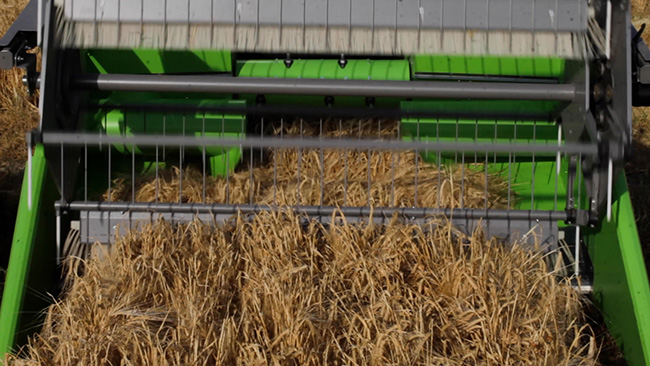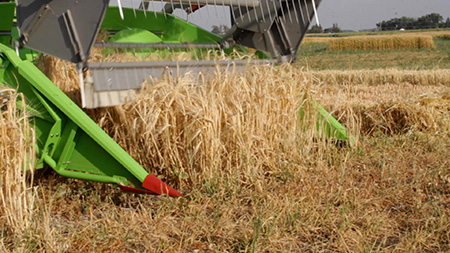As fall steadily approaches, our teams are busy in the field harvesting. We checked in to see how our Agronomy team was doing!
This year, the Agronomy team is busy handling nearly 40 projects, many of which have replicated trials throughout Alberta. Following the data as it comes in keeps the team moving forward while they're busy getting crops out of the ground.
"I enjoy the sense of accomplishment you get seeing everything come together," says Mike Gretzinger, Farming Smarter Research Coordinator.

"I'll see the plots come up on the yield monitor as we combine. Right away, I see which treatments are yielding better than others," says Carlo Van Herk, Farming Smarter Research Technician.
For our researchers, seeing the data come into Excel and fill out charts and graphs feels like Christmas. Their excitement growing as they guess the result of each trial, as if guessing presents based on the shape of the wrapping paper, but for now they must eagerly wait.
However, harvest isn't all fun and games for our crew. Due to the intense requirements of harvest, we find ourselves stretched thin with crews on the road and in the field taking crops off. Unfortunately, we've also lost most of our crew as the students return to school and summer contracts end.
Juggling Time and People
Harvest isn't the only thing our Agronomy team has on their minds. We are continuing our cover crop research this fall with two new cover crop studies funded through RBC Tech for Nature.
These studies will both investigate termination methods for cover crops in hopes of maximizing ecological benefits. We will be testing strip-tilling and roller crimping on fall-seeded cover crops to establish living mulch for summer crops.
Preparation for these studies has the team split into two units, one looking after harvesting our summer trials and the other preparing for fall seeding.
"Our biggest obstacle is overcoming the logistical challenges of transporting equipment and sending the right people. We need to know where we're going to get seed from and if plot sizes need to change," comments Gretzinger.
As Research Coordinator, Gretzinger is busy in the office settling the fall logistics. Currently, he's juggling people between harvesting, soil sampling, and seeding prep.
Meanwhile, Van Herk is busy moving the field crew through the last half of harvest.
"Right now, we're harvesting wheat and canola," says Van Herk. "Hopefully we can finish up most of it this week or early next week."
After finishing with wheat and canola, Van Herk says that hemp and quinoa are not far behind.
"So, we'll be taking hemp and quinoa off in the next week and a half to two weeks. And then, before you know it, we'll be going into silage corn and green corn towards the end of October," he adds.
Following harvest, the field crews will turn their full attention to fall seeding.
"We really want to get our fall seeded stuff in as soon as we can and hopefully get some irrigation on top of it."
Helpful Tips for Surviving Harvest
Harvest can be a stressful time, especially when there's other work to do alongside it. Thankfully, our team has developed a list of tips to survive harvest. If they work for us, hopefully they work for you too!
First and foremost, our biggest tip for harvest is plan things out! With so much going on, it's easy to get lost in the weeds. Taking time to plan everything ahead of time helps you stay on track.
We find lots of value in planning ahead of time. With how many different kinds of work we get caught up in, we'd be dead in the water without effective planning!
The second, calibrate your equipment properly.
"You need to spend the time to make sure your equipment is properly set," says Gretzinger.
"Making sure your equipment is properly set up beforehand saves so much time, and so many headaches out in the field. It can make or break it, especially on the research trials."

"Preventative maintenance is a big thing that is easily forgotten," adds Gretzinger. "Sometimes, it's like we wait for things to break, but you're better off in a lot of cases just repairing everything every fall."
Staying on-top of preventative maintenance is a practice we've recently put more work into at Farming Smarter. Knowing which parts breakdown frequently is important, but a broken piece in the middle of the season can put us weeks behind schedule.
Our final tip is to make sure you find time to relax at the end of the day. Whether it's enjoying a nice, cold refreshment or just kicking your feet up ≥ when the job is done take some time to enjoy the little things.
What's Next for Agronomy
After they finish harvest, our Agronomy team will enjoy a brief reprieve before diving straight into planning for next year.
Not only are there lots of fall seeded projects coming up, but there's also still lots of data from this summer to analyze. As well, teams will be busy with mowing and prepping plots for next year all the way up until November.
To stay connected to our Agronomy team, follow @FarmingSmarter on Twitter or purchase an Agronomy Smarts subscription for immediate updates and exclusive content!
